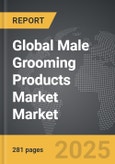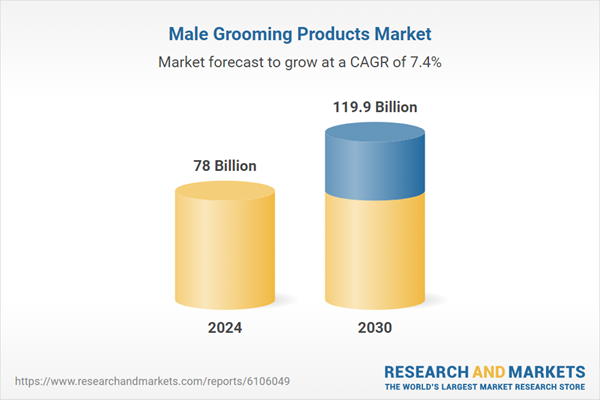Global Male Grooming Products Market - Key Trends & Drivers Summarized
Why Is Male Grooming Experiencing a Cultural and Commercial Shift Across the Globe?
The global market for male grooming products is undergoing a remarkable transformation, driven by shifting cultural norms, increased self-awareness, and a broader definition of masculinity. Where once grooming for men was largely limited to basic hygiene products like razors, shaving creams, and deodorants, today's male consumers are increasingly engaging with a diverse range of personal care categories including skincare, haircare, beard grooming, fragrances, and cosmetic enhancements. This evolution is a reflection of broader societal acceptance of self-care as an essential aspect of modern masculinity, moving away from outdated stereotypes that once equated grooming with vanity. Younger generations, especially millennials and Gen Z, are particularly open to experimenting with grooming routines and are actively seeking products that reflect their individual identities and lifestyles. Social media platforms and male influencers in the beauty and fashion space are playing a crucial role in normalizing male grooming habits and introducing audiences to product innovations. Additionally, the growing importance of personal image in professional and social settings is encouraging men to invest in appearance-enhancing solutions that go beyond the basics. As the stigma surrounding male grooming continues to fade, more men are turning to specialized skincare regimens, anti-aging products, hair styling treatments, and even subtle cosmetics such as concealers or tinted moisturizers. This cultural and psychological shift is fueling demand and encouraging brands to develop tailored, masculine-centric products that meet the specific needs of male consumers across different age groups and regions.How Are Product Innovation and Customization Shaping the Modern Male Grooming Market?
Product innovation and customization are at the core of the rapidly evolving male grooming industry, as brands respond to consumer demands for effective, appealing, and tailored solutions. With increasing awareness of skincare and personal hygiene, men are no longer satisfied with generic formulations and are seeking products that address specific concerns such as oily skin, acne, razor bumps, hair thinning, or beard maintenance. Companies are innovating with multi-functional products that combine cleansing, moisturizing, and sun protection, making grooming more efficient and less time-consuming. Beard oils, sculpting balms, anti-pollution face washes, and caffeine-infused eye creams are just a few examples of specialized offerings that have emerged in response to this trend. The rise of clean beauty and natural formulations is also influencing the male grooming segment, with a noticeable increase in products that are free from parabens, sulfates, synthetic fragrances, and other irritants. Packaging and branding strategies are being refined to reflect masculinity in a way that is modern and inclusive, often emphasizing minimalism, sustainability, and functionality. Subscription-based services and direct-to-consumer models are allowing for personalized product recommendations based on skin type, grooming habits, and lifestyle factors, enhancing customer engagement and satisfaction. Furthermore, artificial intelligence and data analytics are being used to deliver bespoke grooming regimens through online platforms. This drive for personalization and technological sophistication is positioning male grooming as a high-growth, innovation-driven market with the potential to reshape long-standing industry norms.What Consumer Trends and Lifestyle Changes Are Expanding the Reach of Male Grooming Products?
A range of shifting consumer behaviors and lifestyle trends is expanding the demand for male grooming products across global markets. Urbanization, rising disposable income, and greater participation in the global workforce are contributing to increased spending on personal care, particularly in emerging economies where grooming is now associated with professionalism, confidence, and social mobility. The fitness and wellness movement is also encouraging men to adopt grooming routines that align with a holistic approach to health and appearance. Consumers are placing greater emphasis on self-presentation, not only for dating and social media presence but also for virtual work environments where facial visibility through video calls adds a new dimension to personal grooming. The growth of e-commerce and the accessibility of global brands have democratized grooming, allowing consumers in smaller cities and rural areas to explore and purchase a wide range of products previously unavailable to them. The COVID-19 pandemic played a surprising role in reinforcing self-care habits, with men turning to at-home grooming solutions while salons and barbershops were closed. As a result, there is now sustained interest in DIY grooming kits, home skincare treatments, and instructional content that guides users through proper grooming techniques. Cultural shifts that embrace gender fluidity and personal expression are also opening up new opportunities for cosmetic products targeted at men, challenging the binary approach to beauty. These trends are combining to create a broader and more diverse consumer base that is open to engaging with grooming products as an everyday essential rather than an occasional indulgence.What Factors Are Driving Growth in the Global Male Grooming Products Market?
The growth in the global male grooming products market is driven by a combination of demographic changes, rising awareness of personal care, increased market segmentation, and aggressive brand engagement strategies. As men become more proactive about their appearance and health, demand is rising for targeted products that address specific grooming needs while also offering ease of use and visible results. The expanding middle class in Asia, Latin America, and Africa is introducing a vast new customer base eager to adopt global grooming trends and invest in quality products. Brands are responding by tailoring product lines to local skin types, hair textures, climate conditions, and cultural preferences, which is helping to accelerate market penetration. Celebrity endorsements, influencer marketing, and male-focused grooming campaigns are elevating brand visibility and shaping consumer preferences. Additionally, the entry of high-end and luxury brands into the male segment is appealing to a new generation of affluent consumers willing to spend on premium grooming experiences. Innovations in packaging and product delivery systems such as roll-ons, sticks, and portable kits are making grooming more convenient for modern lifestyles. Retail environments, both physical and digital, are increasingly featuring male-dedicated spaces and curated sections, which encourage exploration and repeat purchasing. Furthermore, rising concern about skin health, aging, and pollution is driving the development of more advanced and dermatologically tested formulations. These drivers are collectively supporting a sustained upward trajectory for the male grooming market, signaling robust opportunities for brands that are responsive, inclusive, and forward-thinking in their approach.Report Scope
The report analyzes the Male Grooming Products market, presented in terms of market value (US$). The analysis covers the key segments and geographic regions outlined below:- Segments: Distribution Channel (Offline Distribution Channel, Online Distribution Channel); Application (Shave Care Application, Hair Care Application, Skin Care Application, Fragrance Application, Other Applications).
- Geographic Regions/Countries: World; United States; Canada; Japan; China; Europe (France; Germany; Italy; United Kingdom; Spain; Russia; and Rest of Europe); Asia-Pacific (Australia; India; South Korea; and Rest of Asia-Pacific); Latin America (Argentina; Brazil; Mexico; and Rest of Latin America); Middle East (Iran; Israel; Saudi Arabia; United Arab Emirates; and Rest of Middle East); and Africa.
Key Insights:
- Market Growth: Understand the significant growth trajectory of the Offline Distribution Channel segment, which is expected to reach US$69.4 Billion by 2030 with a CAGR of a 5.8%. The Online Distribution Channel segment is also set to grow at 9.9% CAGR over the analysis period.
- Regional Analysis: Gain insights into the U.S. market, valued at $21.3 Billion in 2024, and China, forecasted to grow at an impressive 11.3% CAGR to reach $25 Billion by 2030. Discover growth trends in other key regions, including Japan, Canada, Germany, and the Asia-Pacific.
Why You Should Buy This Report:
- Detailed Market Analysis: Access a thorough analysis of the Global Male Grooming Products Market, covering all major geographic regions and market segments.
- Competitive Insights: Get an overview of the competitive landscape, including the market presence of major players across different geographies.
- Future Trends and Drivers: Understand the key trends and drivers shaping the future of the Global Male Grooming Products Market.
- Actionable Insights: Benefit from actionable insights that can help you identify new revenue opportunities and make strategic business decisions.
Key Questions Answered:
- How is the Global Male Grooming Products Market expected to evolve by 2030?
- What are the main drivers and restraints affecting the market?
- Which market segments will grow the most over the forecast period?
- How will market shares for different regions and segments change by 2030?
- Who are the leading players in the market, and what are their prospects?
Report Features:
- Comprehensive Market Data: Independent analysis of annual sales and market forecasts in US$ Million from 2024 to 2030.
- In-Depth Regional Analysis: Detailed insights into key markets, including the U.S., China, Japan, Canada, Europe, Asia-Pacific, Latin America, Middle East, and Africa.
- Company Profiles: Coverage of players such as Abbott Laboratories, AbbVie Inc., Astellas?Pharma Inc., AstraZeneca PLC, Chiesi Farmaceutici S.p.A. and more.
- Complimentary Updates: Receive free report updates for one year to keep you informed of the latest market developments.
Some of the 41 companies featured in this Male Grooming Products market report include:
- American Crew (Revlon)
- Beiersdorf AG
- Bulldog Skincare for Men
- Colgate-Palmolive Company
- Coty Inc.
- Edgewell Personal Care
- Gillette (P&G)
- Godrej Consumer Products
- Harry’s Inc.
- Johnson & Johnson
- Kao Corporation
- King of Shaves
- L’Oréal Paris Men Expert
- Mandom Corporation (Gatsby)
- Natura & Co. (Aesop, The Body Shop)
- Philips Personal Care
- Procter & Gamble
- Revlon Inc.
- Shiseido Co., Ltd.
- The Estée Lauder Companies
- Unilever PLC
This edition integrates the latest global trade and economic shifts into comprehensive market analysis. Key updates include:
- Tariff and Trade Impact: Insights into global tariff negotiations across 180+ countries, with analysis of supply chain turbulence, sourcing disruptions, and geographic realignment. Special focus on 2025 as a pivotal year for trade tensions, including updated perspectives on the Trump-era tariffs.
- Adjusted Forecasts and Analytics: Revised global and regional market forecasts through 2030, incorporating tariff effects, economic uncertainty, and structural changes in globalization. Includes historical analysis from 2015 to 2023.
- Strategic Market Dynamics: Evaluation of revised market prospects, regional outlooks, and key economic indicators such as population and urbanization trends.
- Innovation & Technology Trends: Latest developments in product and process innovation, emerging technologies, and key industry drivers shaping the competitive landscape.
- Competitive Intelligence: Updated global market share estimates for 2025, competitive positioning of major players (Strong/Active/Niche/Trivial), and refined focus on leading global brands and core players.
- Expert Insight & Commentary: Strategic analysis from economists, trade experts, and domain specialists to contextualize market shifts and identify emerging opportunities.
Table of Contents
Companies Mentioned (Partial List)
A selection of companies mentioned in this report includes, but is not limited to:
- American Crew (Revlon)
- Beiersdorf AG
- Bulldog Skincare for Men
- Colgate-Palmolive Company
- Coty Inc.
- Edgewell Personal Care
- Gillette (P&G)
- Godrej Consumer Products
- Harry’s Inc.
- Johnson & Johnson
- Kao Corporation
- King of Shaves
- L’Oréal Paris Men Expert
- Mandom Corporation (Gatsby)
- Natura & Co. (Aesop, The Body Shop)
- Philips Personal Care
- Procter & Gamble
- Revlon Inc.
- Shiseido Co., Ltd.
- The Estée Lauder Companies
- Unilever PLC
Table Information
| Report Attribute | Details |
|---|---|
| No. of Pages | 281 |
| Published | November 2025 |
| Forecast Period | 2024 - 2030 |
| Estimated Market Value ( USD | $ 78 Billion |
| Forecasted Market Value ( USD | $ 119.9 Billion |
| Compound Annual Growth Rate | 7.4% |
| Regions Covered | Global |









